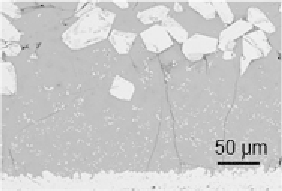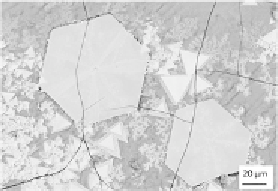Biomedical Engineering Reference
In-Depth Information
(a)
(b)
Figure 12.
Optical micrographs of sessile drop cross sections: (a) Ni/HfB
2
couple showing the par-
ticular sigmoidal interface; (b) NiB50/HfB
2
with a flat solid-liquid interface.
(a)
(b)
Figure 13.
SEM images (BE mode) of Ni-HfB
2
system. Details of the internal structure of the solid-
ified drop: (a) pure Ni: solid-liquid interface, with big HfB
2
crystals grown inside the liquid phase.
(b) HfB
2
crystals, from primary solidification at the surface of the drop.
and the subsequent de-pinning followed by fast drop spreading along the substrate
surface. No new products are seen at the interface, except for a layer of HfB
2
phase
newly formed by the dissolution-precipitation process (dissolutive wetting).
Compared to pure Ni, the NiB50 alloy shows no dissolution of HfB
2
with the
consequent formation of a flat, 'undisturbed' interface as predicted by the calculated
phase diagram.
The SEM image (Fig. 13a) of the pure Ni/HfB
2
couple shows relevant recrys-
tallisation of HfB
2
crystals at the solid-liquid interface, about ten times larger than
the original sintered ones and (Fig. 13b) at the liquid surface in the form of thin,
hexagonal platelets. The solidified Ni-based alloy has an eutectic structure with a
large part composed of the intermetallic compound Hf
2
Ni
21
B
6
(theoretical compo-
sition B 21%, Ni 72%, Hf 7%) which is foreseen to appear below 1220
◦
Candan
intermetallic phase whose composition is close to Ni
3
B.
The NiB50 alloy (Fig. 14) reveals, after solidification, no boride recrystallization
both at the interface and in the bulk alloy, and an eutectic structure with a NiB light
grey phase and a Ni
4
B
3
dark grey one. No Hf has been detected in the liquid phase.
Joining.
Joining of transition metal diborides is a topic which is increasingly
attracting research in force of its intrinsic interest for advanced applications, mainly
in transport, energy and aerospace industry. In recent years a number of papers
has appeared, addressing different aspects of bonding technology of such materials
[148-156].
Also in our laboratory, on the basis of the experimental and theoretical findings
reported in the previous paragraphs, ZrB
2
and HfB
2
joining tests have been made,




Search WWH ::

Custom Search